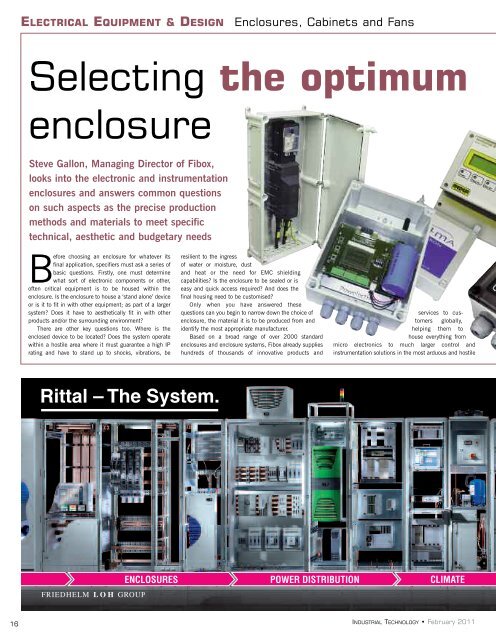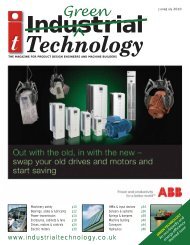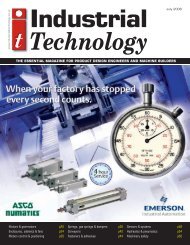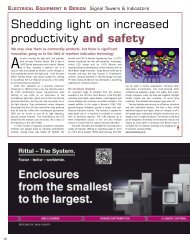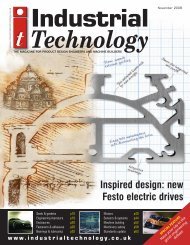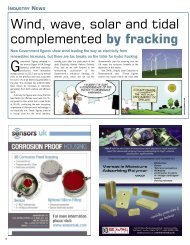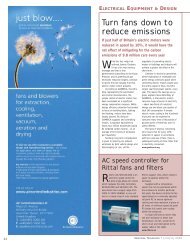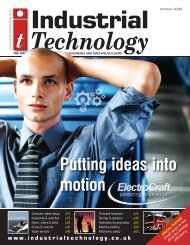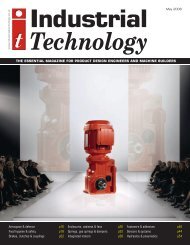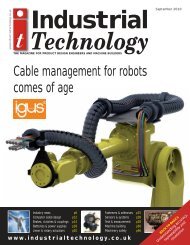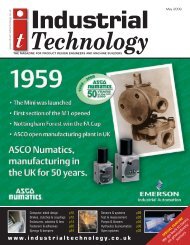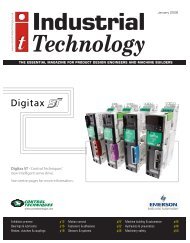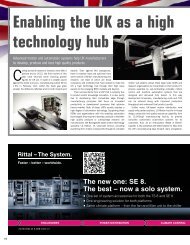View advert- Page 16 - Industrial Technology Magazine
View advert- Page 16 - Industrial Technology Magazine
View advert- Page 16 - Industrial Technology Magazine
You also want an ePaper? Increase the reach of your titles
YUMPU automatically turns print PDFs into web optimized ePapers that Google loves.
ELECTRICAL EQUIPMENT & DESIGN<br />
Enclosures, Cabinets and Fans<br />
Selecting the optimum<br />
enclosure<br />
Steve Gallon, Managing Director of Fibox,<br />
looks into the electronic and instrumentation<br />
enclosures and answers common questions<br />
on such aspects as the precise production<br />
methods and materials to meet specific<br />
technical, aesthetic and budgetary needs<br />
Before choosing an enclosure for whatever its<br />
final application, specifiers must ask a series of<br />
basic questions. Firstly, one must determine<br />
what sort of electronic components or other,<br />
often critical equipment is to be housed within the<br />
enclosure. Is the enclosure to house a ‘stand alone’ device<br />
or is it to fit in with other equipment; as part of a larger<br />
system? Does it have to aesthetically fit in with other<br />
products and/or the surrounding environment?<br />
There are other key questions too. Where is the<br />
enclosed device to be located? Does the system operate<br />
within a hostile area where it must guarantee a high IP<br />
rating and have to stand up to shocks, vibrations, be<br />
resilient to the ingress<br />
of water or moisture, dust<br />
and heat or the need for EMC shielding<br />
capabilities? Is the enclosure to be sealed or is<br />
easy and quick access required? And does the<br />
final housing need to be customised?<br />
Only when you have answered these<br />
questions can you begin to narrow down the choice of<br />
enclosure, the material it is to be produced from and<br />
identify the most appropriate manufacturer.<br />
Based on a broad range of over 2000 standard<br />
enclosures and enclosure systems, Fibox already supplies<br />
hundreds of thousands of innovative products and<br />
services to customers<br />
globally,<br />
helping them to<br />
house everything from<br />
micro electronics to much larger control and<br />
instrumentation solutions in the most arduous and hostile<br />
Rittal – The System.<br />
ENCLOSURES<br />
POWER DISTRIBUTION<br />
CLIMATE<br />
<strong>16</strong><br />
INDUSTRIAL TECHNOLOGY • February 2011
of environments. As well as standard products, highly<br />
customised enclosures are also available direct from our<br />
manufacturing plants with very short lead times. OEMs<br />
can save time and money with access to Fibox’s fast<br />
prototype service and the facility to order ready modified<br />
enclosures in place of standard products.<br />
With the development of new software and internet<br />
based services, Fibox customers can now download CAD<br />
drawings and design in house a fully customised<br />
enclosure solution. Fibox can then, in a matter of<br />
minutes, provide a quotation for this work<br />
and arrange a prototype. Enclosures<br />
designed to house the<br />
multitude of applications<br />
required of them come in<br />
various forms, with materials<br />
including steel, stainless, die<br />
cast aluminium, polycarbonate,<br />
GRP and ABS – each of which<br />
must be assessed in the light of<br />
offering the best possible<br />
protection for the<br />
environment it is to<br />
operate in. In<br />
serving both<br />
traditional<br />
and emerging<br />
markets,<br />
Fibox<br />
recognises today’s<br />
changing<br />
industrial dynamics.<br />
The ability to<br />
deliver quality engineered<br />
products in ever<br />
shorter lead times is critical.<br />
Time-to-market for new products is decreasing; meaning<br />
more specialist products are created based on a madeto-order<br />
basis and even occasionally manufactured as<br />
one-offs, while at the same time the complexity and<br />
variety of those products are increasing. If you are<br />
manufacturing families of control systems and<br />
instruments, then the ability to source and customise<br />
different sized enclosures from the same manufacturer to<br />
maintain your product identity could well be of<br />
paramount importance.<br />
Hostile environments<br />
Undoubtedly a sizeable majority of industrial controls<br />
and instrumentation (for example, remote telemetry<br />
equipment) needs to be installed in hostile<br />
environments, and very frequently in inaccessible<br />
locations and therefore a different set of criteria become<br />
important: IP rating, UV stability, temperature<br />
classification, durability and robustness of material, anticorrosion<br />
qualities and the need to be RoHS compliant.<br />
<strong>Industrial</strong> enclosures are increasingly used to house and<br />
protect equipment not normally associated with the<br />
traditional electronic and electrical industry. A recent<br />
example is fire extinguishers on the decks of cruise ships.<br />
So when you’re looking for an enclosure supplier, do you<br />
need assurances that this trend is in the mind of its<br />
designers when innovating new product ranges – that they<br />
have very much a blinkers off approach to product<br />
development. It’s a fact that the ultimate reliability of the<br />
system or device you build and supply is as much<br />
influenced by the initial choice and design of the enclosure,<br />
as it is by the components used, to build the system itself.<br />
So, if you have an unusual application and need help in<br />
defining and choosing an enclosure solution for your<br />
problem, start by asking a few questions.<br />
www.fibox.co.uk<br />
Junction box<br />
solves solar<br />
cable problem<br />
Spelsberg’s new PV48 junction box provides<br />
a specific and inexpensive solution to the<br />
annoying problem on photovoltaic panels, of<br />
standard cables being too short. Designed to seal<br />
cable diameters of between 4-7mm, the PV48<br />
allows simple cable extension, providing a quick,<br />
secure cage clamp connection within a discrete<br />
IP65-rated junction box.<br />
Chris Lloyd, Sales and Marketing Manager for<br />
Spelsberg, comments: “As standard, photovoltaic<br />
panels rarely have more than a maximum of 2m<br />
of cable attached. This means that installers<br />
regularly need to use a junction box or install<br />
expensive extension cables to extend the cabling<br />
length. The PV48 is the first junction box on the<br />
market designed for this specific job, as such it<br />
fulfils all the requirements for the application.”<br />
The PV48 junction box has two in-line cable<br />
entry points that use M<strong>16</strong> cable glands to ensure<br />
quick and secure cable entry. The connection is<br />
made using a cage clamp terminal: a 5.5mm flat<br />
blade screwdriver is used to open the connection<br />
point, which the exposed wire is pushed through.<br />
When the screwdriver is removed, a secure<br />
connection is made automatically. The box cover<br />
clips into place, forming an IP65 seal.<br />
www.spelsberg.co.uk<br />
Faster – better – worldwide.<br />
CONTROL<br />
IT INFRASTRUCTURE<br />
SOFTWARE & SERVICES<br />
www.rittal.co.uk<br />
February 2011 • INDUSTRIAL TECHNOLOGY<br />
17


